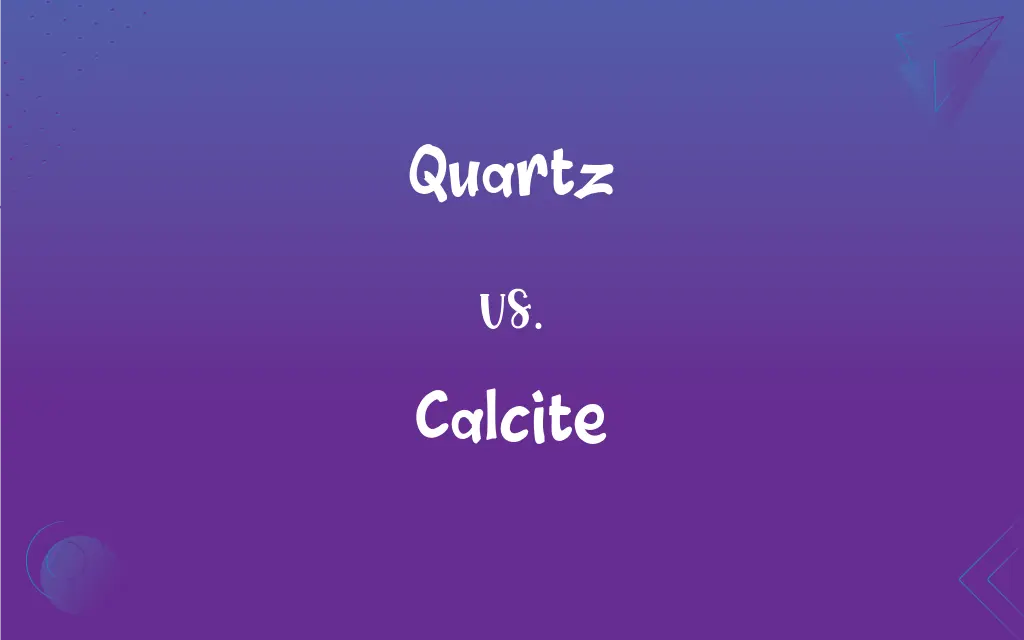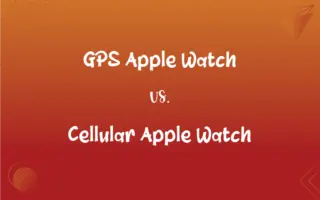Quartz vs. Calcite: What's the Difference?
Edited by Aimie Carlson || By Harlon Moss || Published on February 14, 2024
Quartz is a hard, crystalline mineral composed of silicon and oxygen, while calcite is a softer carbonate mineral made of calcium carbonate.

Key Differences
Quartz is composed of silicon dioxide (SiO2), a hard, crystalline mineral. Calcite, made of calcium carbonate (CaCO3), is a softer mineral often found in sedimentary rocks.
Quartz has a higher hardness (7 on the Mohs scale), making it more durable. Calcite is softer, with a Mohs hardness of 3, and is more easily scratched or eroded.
Quartz is known for its glass-like luster and can be transparent to translucent. Calcite commonly has a waxy luster and can exhibit double refraction, where images appear doubled when viewed through the mineral.
Quartz is widely used in jewelry, electronics, and as a building material. Calcite has numerous uses, including in cement production, agriculture (as lime), and as a material in the optical industry.
Quartz is one of the most abundant minerals in the Earth's crust, found in igneous, metamorphic, and sedimentary rocks. Calcite is primarily found in sedimentary rocks like limestone and is a key component of marine organisms' shells.
ADVERTISEMENT
Comparison Chart
Chemical Composition
Silicon dioxide (SiO2).
Calcium carbonate (CaCO3).
Mohs Hardness
7, making it quite hard and durable.
3, softer and easily scratched.
Physical Appearance
Glass-like luster, transparent to translucent.
Waxy luster, exhibits double refraction.
Uses
Jewelry, electronics, building materials.
Cement, agriculture, optical industry.
Occurrence
Abundant in various rock types.
Primarily in sedimentary rocks, like limestone.
ADVERTISEMENT
Quartz and Calcite Definitions
Quartz
Known for its durability and glass-like appearance.
Quartz countertops are popular for their durability.
Calcite
A carbonate mineral made of calcium carbonate.
The limestone rock is composed mainly of calcite.
Quartz
A hard, crystalline mineral composed of silicon dioxide.
The quartz crystals in the cave sparkled in the light.
Calcite
Used in the production of cement and agricultural lime.
Calcite is an important ingredient in making cement.
Quartz
Found in a variety of colors, from clear to various hues.
Amethyst is a purple variety of quartz.
Calcite
A common part of sedimentary rocks like limestone and marble.
Marble, used in sculpture, is made of recrystallized calcite.
Quartz
Used in making jewelry and various electronic devices.
Quartz is used in watches due to its piezoelectric properties.
Calcite
Characterized by its softness and waxy luster.
Calcite scratches easily due to its low hardness.
Quartz
One of the most abundant minerals in the Earth's crust.
Quartz sand is a common component of beach sand.
Calcite
Exhibits the property of double refraction.
Viewing objects through calcite crystal can create a doubled image.
Quartz
A very hard mineral composed of silica, SiO2, found worldwide in many different types of rocks, including sandstone and granite. Varieties of quartz include agate, chalcedony, chert, flint, opal, and rock crystal.
Calcite
A common crystalline form of natural calcium carbonate, CaCO3, that is the basic constituent of limestone, marble, and chalk. Also called calcspar.
Quartz
(mineral) The most abundant mineral on the earth's surface, of chemical composition silicon dioxide, SiO2. It occurs in a variety of forms, both crystalline and amorphous. Found in every environment.
Calcite
(mineral) a very widely distributed crystalline form of calcium carbonate, CaCO3, found as limestone, chalk and marble
Quartz
Crystal meth: methamphetamine hydrochloride.
Calcite
Calcium carbonate, or carbonate of lime. It is rhombohedral in its crystallization, and thus distinguished from aragonite. It includes common limestone, chalk, and marble. Called also calc-spar and calcareous spar.
Quartz
A form of silica, or silicon dioxide (SiO2), occurring in hexagonal crystals, which are commonly colorless and transparent, but sometimes also yellow, brown, purple, green, and of other colors; also in cryptocrystalline massive forms varying in color and degree of transparency, being sometimes opaque.
Calcite
A common mineral consisting of crystallized calcium carbonate; a major constituent of limestone
Quartz
Colorless glass made of almost pure silica
Quartz
A hard glossy mineral consisting of silicon dioxide in crystal form; present in most rocks (especially sandstone and granite); yellow sand is quartz with iron oxide impurities
FAQs
What is quartz?
Quartz is a hard mineral made of silicon dioxide.
Can quartz be used in jewelry?
Yes, quartz is commonly used in jewelry due to its hardness and beauty.
What is double refraction in calcite?
Double refraction is when light splits into two rays as it passes through calcite, creating a double image.
What is the industrial use of calcite?
Calcite is used in cement production, agricultural lime, and in the optical industry.
Can calcite be transparent?
Calcite can be translucent to transparent.
How is calcite formed?
Calcite forms in sedimentary settings and is often a component of marine organism shells.
What colors does quartz come in?
Quartz can be clear, white, or various colors like pink (rose quartz), purple (amethyst).
Is calcite found in limestone?
Yes, calcite is a major component of limestone.
Is quartz resistant to weathering?
Quartz is highly resistant to weathering due to its hardness.
How is quartz formed?
Quartz forms from cooling magma and can also be found in sedimentary and metamorphic rocks.
Is calcite used in agriculture?
Yes, calcite, in the form of lime, is used to neutralize acidic soil in agriculture.
Are quartz countertops durable?
Yes, quartz countertops are known for their durability and resistance to scratches.
Is calcite soft or hard?
Calcite is relatively soft, with a Mohs hardness of 3.
What geological processes involve quartz?
Quartz is involved in igneous, metamorphic, and sedimentary processes.
Does calcite react with acid?
Yes, calcite reacts with acids, fizzing upon contact with dilute hydrochloric acid.
Is quartz piezoelectric?
Yes, quartz exhibits piezoelectric properties, making it useful in electronic devices.
What is the Mohs hardness of quartz?
Quartz has a Mohs hardness of 7.
What are common colors of calcite?
Calcite is typically white or colorless but can have impurities that impart colors like red, yellow, or blue.
Can quartz be found in sand?
Yes, quartz is a major component of many types of sand.
Does calcite have any optical properties?
Besides double refraction, calcite can show fluorescence under UV light.
About Author
Written by
Harlon MossHarlon is a seasoned quality moderator and accomplished content writer for Difference Wiki. An alumnus of the prestigious University of California, he earned his degree in Computer Science. Leveraging his academic background, Harlon brings a meticulous and informed perspective to his work, ensuring content accuracy and excellence.
Edited by
Aimie CarlsonAimie Carlson, holding a master's degree in English literature, is a fervent English language enthusiast. She lends her writing talents to Difference Wiki, a prominent website that specializes in comparisons, offering readers insightful analyses that both captivate and inform.







































































